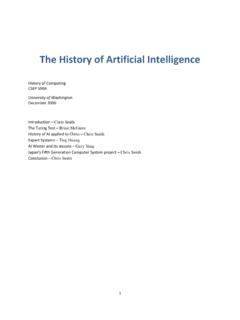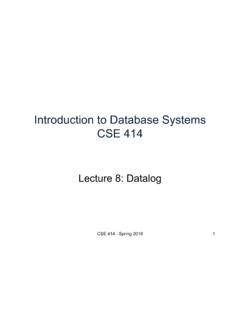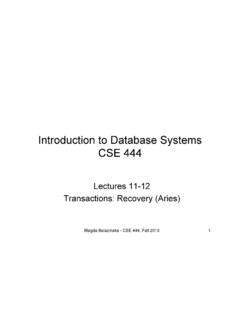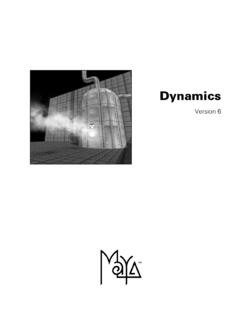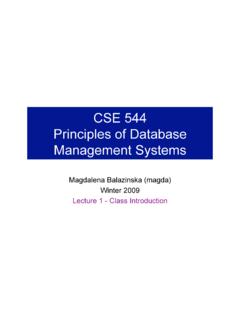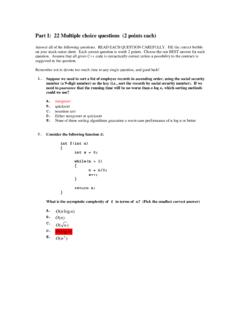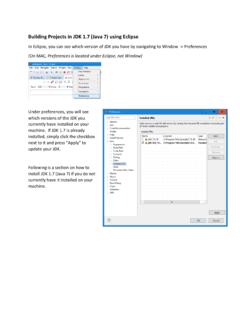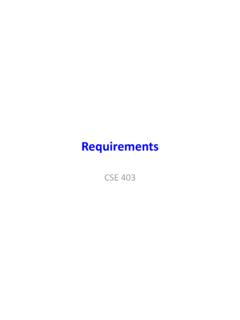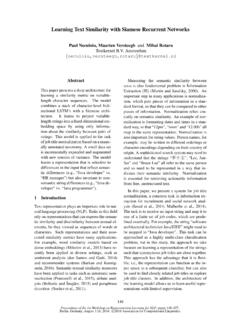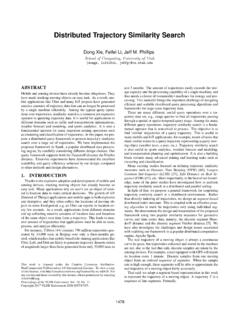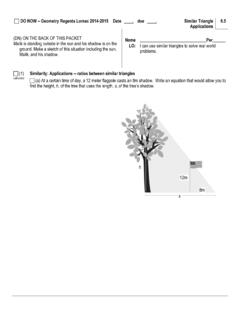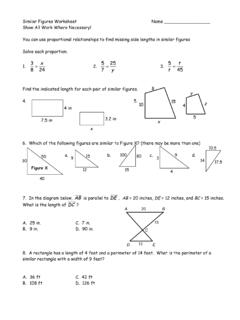Transcription of Document Similarity in Information Retrieval
1 Document Similarity in Information Retrieval Mausam (Based on slides of W. Arms, Thomas Hofmann, Ata Kaban, Melanie Martin) Standard Web Search Engine Architecture crawl the web create an inverted index store documents, check for duplicates, extract links inverted index DocIds Slide adapted from Marti Hearst / UC Berkeley] Search engine servers user query show results To user Indexing Subsystem Documents break into tokens stop list* stemming* term weighting* Index database text non-stoplist tokens tokens stemmed terms terms with weights *Indicates optional operation. assign Document IDs documents Document numbers and *field numbers Search Subsystem Index database query parse query stemming* stemmed terms stop list* non-stoplist tokens query tokens Boolean operations* ranking* relevant Document set ranked Document set retrieved Document set *Indicates optional operation.
2 Terms vs tokens Terms are what results after tokenization and linguistic processing. Examples knowledge -> knowledg The -> the Removal of stop words Matching/Ranking of Textual Documents Major Categories of Methods matching (Boolean) by Similarity to query (vector space model) of matches by importance of documents (PageRank) methods What happens in major search engines (Googlerank) Vector representation of documents and queries Why do this? Represents a large space for documents Compare Documents Documents with queries Retrieve and rank documents with regards to a specific query - Enables methods of Similarity All search engines do this. Boolean queries Document is relevant to a query of the query itself is in the Document . Query blue and red brings back all documents with blue and red in them Document is either relevant or not relevant to the query.
3 What about relevance ranking partial relevance. Vector model deals with this. Similarity Measures and Relevance Retrieve the most similar documents to a query Equate Similarity to relevance Most similar are the most relevant This measure is one of text Similarity The matching of text or words Similarity Ranking Methods Query Documents Index database Mechanism for determining the Similarity of the query to the Document . Set of documents ranked by how similar they are to the query Term Similarity : Example Problem: Given two text documents, how similar are they? [Methods that measure Similarity do not assume exact matches.] Example (assume tokens converted to terms) Here are three documents. How similar are they? d1 ant ant bee d2 dog bee dog hog dog ant dog d3 cat gnu dog eel fox Documents can be any length from one word to thousands.
4 A query is a special type of Document . Bag of words view of a doc Tokens are extracted from text and thrown into a bag without order and labeled by Document . Thus the doc John is quicker than Mary. is indistinguishable from the doc Mary is quicker than John. is John quicker Mary than Two documents are similar if they contain some of the same terms. Possible measures of Similarity might take into consideration: (a) The lengths of the documents (b) The number of terms in common (c) Whether the terms are common or unusual (d) How many times each term appears Term Similarity : Basic Concept TERM VECTOR SPACE Term vector space n-dimensional space, where n is the number of different terms/tokens used to index a set of documents. Vector Document i, di, represented by a vector. Its magnitude in dimension j is wij, where: wij > 0 if term j occurs in Document i wij = 0 otherwise wij is the weight of term j in Document i.
5 A Document Represented in a 3-Dimensional Term Vector Space t1 t2 t3 d1 t13 t12 t11 Basic Method: Incidence Matrix (Binary Weighting) Document text terms d1 ant ant bee ant bee d2 dog bee dog hog dog ant dog ant bee dog hog d3 cat gnu dog eel fox cat dog eel fox gnu ant bee cat dog eel fox gnu hog d1 1 1 d2 1 1 1 1 d3 1 1 1 1 1 Weights: tij = 1 if Document i contains term j and zero otherwise 3 vectors in 8-dimensional term vector space Basic Vector Space Methods: Similarity between 2 documents The Similarity between two documents is a function of the angle between their vectors in the term vector space.
6 T1 t2 t3 d1 d2 Vector Space Revision x = (x1, x2, x3, .., xn) is a vector in an n-dimensional vector space Length of x is given by (extension of Pythagoras's theorem) |x|2 = x12 + x22 + x32 + .. + xn2 |x| = ( x12 + x22 + x32 + .. + xn2 )1/2 If x1 and x2 are vectors: Inner product (or dot product) is given by = x11x21 + x12x22 + x13x23 + .. + x1nx2n Cosine of the angle between the vectors x1 and x2: cos ( ) = |x1| |x2| Document Similarity d = (x1, x2, x3, .., xn) is a vector in an n-dimensional vector space Length of x is given by (extension of Pythagoras's theorem) |d|2 = x12 + x22 + x32 + .. + xn2 |d| = ( x12 + x22 + x32 + .. + xn2 )1/2 If d1 and d2 are Document vectors: Inner product (or dot product) is given by = x11x21 + x12x22 + x13x23 +.
7 + x1nx2n Cosine angle between the docs d1 and d2 determines doc Similarity cos ( ) = |d1| |d2| cos ( ) = 1; documents exactly the same; = 0, totally different Example 1 No Weighting ant bee cat dog eel fox gnu hog length d1 1 1 2 d2 1 1 1 1 4 d3 1 1 1 1 1 5 Ex: length d1 = (12+12)1/2 Example 1 (continued) d1 d2 d3 d1 1 0 d2 1 d3 0 1 Similarity of documents in example: Digression: terminology WARNING: In a lot of IR literature, frequency is used to mean count Thus term frequency in IR literature is used to mean number of occurrences in a doc Not divided by Document length (which would actually make it a frequency) We will conform to this misnomer In saying term frequency we mean the number of occurrences of a term in a Document .
8 Example 2 Weighting by Term Frequency (tf) ant bee cat dog eel fox gnu hog length d1 2 1 5 d2 1 1 4 1 19 d3 1 1 1 1 1 5 Weights: tij = frequency that term j occurs in Document i Document text terms d1 ant ant bee ant bee d2 dog bee dog hog dog ant dog ant bee dog hog d3 cat gnu dog eel fox cat dog eel fox gnu Example 2 (continued) d1 d2 d3 d1 1 0 d2 1 d3 0 1 Similarity of documents in example: Similarity depends upon the weights given to the terms. [Note differences in results from Example 1.] Summary: Vector Similarity Computation with Weights Documents in a collection are assigned terms from a set of n terms The term vector space W is defined as: if term k does not occur in Document di, wik = 0 if term k occurs in Document di, wik is greater than zero (wik is called the weight of term k in Document di) Similarity between di and dj is defined as: wikwjk |di| |dj| Where di and dj are the corresponding weighted term vectors and |di| is the length of the Document vector di k=1 n cos(di, dj) = Summary: Vector Similarity Computation with Weights Inner product (or dot product) between documents = w11w21 + w12w22 + w13w23 +.
9 + w1nw2n Inner product (or dot product) is between a Document and query = w11wq11 + w12wq12 + w13wq13 + .. + w1nwq1n where wqij is the weight of the jth term of the ith query Simple Uses of Vector Similarity in Information Retrieval Threshold For query q, retrieve all documents with Similarity above a threshold, , Similarity > Ranking For query q, return the n most similar documents ranked in order of Similarity . [This is the standard practice.] Simple Example of Ranking (Weighting by Term Frequency) ant bee cat dog eel fox gnu hog length q 1 1 2 d1 2 1 5 d2 1 1 4 1 19 d3 1 1 1 1 1 5 query q ant dog Document text terms d1 ant ant bee ant bee d2 dog bee dog hog dog ant dog ant bee dog hog d3 cat gnu dog eel fox cat dog eel fox gnu Calculate Ranking d1 d2 d3 q 2/ 10 5/ 38 1/ 10 Similarity of query to documents in example.
10 If the query q is searched against this Document set, the ranked results are: d2, d1, d3 Bigger Corpora Consider n = 1M documents, each with about 1K terms. Avg 6 bytes/term incl spaces/punctuation 6GB of data. Say there are m = 500K distinct Can t Build the Matrix 500K x 1M matrix: 500 Billion 0 s and 1 s. But it has no more than 1 billion 1 s. matrix is extremely sparse. What s a better representation? Documents are parsed to extract words and these are saved with the Document ID. I did enact Julius Caesar I was killed i' the Capitol; Brutus killed me. Doc 1 So let it be with Caesar. The Noble Brutus hath told you Caesar was ambitious Doc 2 TermDoc #I1did1enact 1julius1caesar1I1was1killed1i'1the1capit ol1brutus1killed1me1so2let2it2be2with2ca esar2the2noble 2brutus2hath 2told 2you2caesar 2was2ambitious2 Inverted index Later.

